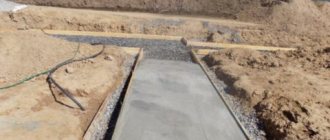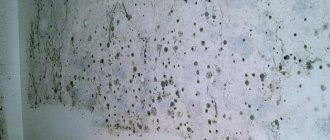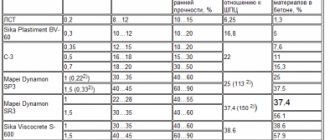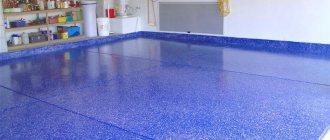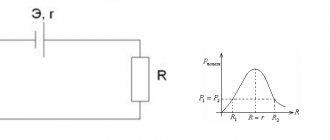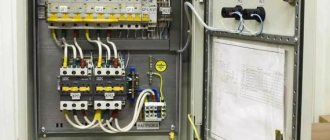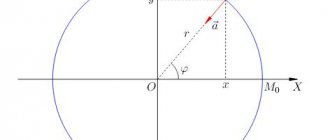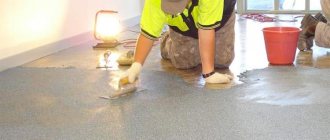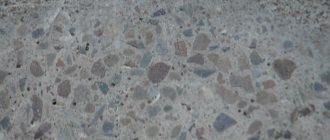Description of the concept
The surface modulus is the ratio of the cooled or heated area using a building material to its volume. This parameter is important both for construction and for the operation process, since it determines the conditions of use and durability of the material.
Mn = S/V – formula:
- MP – surface modulus;
- S – structure area;
- V is the volume of the monolith.
There are several ways to calculate its values, which are intended for real structures. Also, when drawing up the formula, the method of pouring and the presence of additional elements, the thickness of the layer, and the conditions under which the base is dried are taken into account. If the concrete surface is incorrectly calculated, this can lead to the wrong choice of heating technology, the appearance of surface defects, cracks and faults.
When laying the mixture in winter, the main task facing builders is to provide the concrete with the opportunity to quickly harden under conditions under which it would gain all its characteristics. With frequent precipitation, low temperatures, and climatic changes, it is not recommended to lay concrete.
Definition of quality
If we talk about the ideal time for carrying out concrete work outdoors, then this is certainly the warm season. During such a period, as a rule, positive temperatures prevail, there is no large amount of precipitation, stable sun, due to the heating of which the texture of the material quickly hardens. Unfortunately, it is not always possible to work under such conditions; most often construction is carried out at low temperatures.
During the process of concreting under frost, the main problem appears, the essence of which is the increase in the strength of concrete and the beginning of crystallization of water in it. The main methods for solving it include creating thermal insulation of the formwork or special heating of the laid mixture.
The choice of solution depends on how quickly the mold with the embedded material will harden. This can be determined using special formulas and the ratio of the area to the cooled surface and its volume. The concrete surface modulus helps to solve a number of issues and determine how quickly, in contact with cold air, a given area can harden.
When calculating the modulus in winter, one must take into account the fact that the process of concrete gaining strength stops when the temperature cools to 0 degrees. Only those parts of the surface that are in contact with colder air are considered to be cooled.
Experts advise using additional heating elements that will help quickly solve the problem of hardening of the laid monolith.
Calculation parameters
If we talk about the practical side, then the calculation of beams, cylinders, and additional transitions in diameter can be quite complex. Therefore, craftsmen simplify it and use several formulas for the main structural elements.
When deducting, such tricks as the length of the beam or the height of the column are used; other indicators do not affect the surface modulus and are not taken into account in the calculations. When calculating, the entire surface is taken into account. True, this calculation will be relevant only if it cools as quickly as possible.
That is, the concrete surface stands on frozen ground or is constantly in contact with cold air. Otherwise, its elements are not taken into account. Builders advise using the concrete surface module when drawing up a building design.
This will help calculate the necessary data and take measures that will make the hardening process quick and of high quality.
What affects the modulus of elasticity?
- The properties of the components in concrete have a direct impact. Moreover, this subordination is completely straightforward. For lightweight concretes this figure is lower, but for heavier coarse-grained types it is higher.
- Classification of concrete. To clarify the dependence of the required coefficient, a special table has been compiled. The average consumer uses a small list of these products in his work; for this reason, there is no need to present it in its entirety. Based on the known indicators of strength and modulus, it is clear that they depend proportionally on each other. Moreover, this dependence does not change when exposed to temperatures below 230C. That is, basically the indicators do not change at all. This nuance makes it possible to control such characteristics of the product as elasticity, moreover, this is feasible in the same classes of material. This property is taken into account in order to know which product can be installed. When constructing country private houses, a fairly small list of concrete solutions is used, according to their class. Most often, this choice occurs in the range from B7 to B30, as well as M100, M150, M200, M250, M300, M350, M400. However, this range is completely sufficient for the construction of low-rise buildings. This is possible even if slab plinths are used in construction, and arches are also formed for decoration.
- Age of concrete. The relationship between an increase in the required coefficient and the operating period is known. For this reason, when determining the indicator in the required period of time, special tables are used. It indicates the primary data that must be multiplied by correction modules.
- Component processing method. An important role is played by the conditions under which the concrete hardened. After all, it could harden naturally, during thermal exposure or using an autoclave.
- Duration of pressure influence. To find out this indicator, the initial indicator is multiplied by the required module. For each type of concrete, this module has its own meaning. For light, heavy and fine-grained - 0.85, for porous - 0.7.
Before studying other nuances that affect the analyzed characteristic, it is necessary to take a closer look at such a definition as concrete creep. This indicator has a great influence on the stage of destruction of the product. After all, under a short-term low load the material is deformed, but after the impact stops it returns to its original state.
This point need not be examined in detail, since it is very difficult to determine the type of deformation. Externally, plastic and elastic deformation are no different. However, it is worth pointing out that plastic failure is explained by the creep property of concrete. In particular, this parameter is taken into account during long-term exposure to the material. The creep modulus also has its own letter designation:
- Moisture content in the ambient air. This circumstance is related to the creep modulus. If an exact value is needed, it can also be found from the corresponding tables. In this case, temperature and background radiation levels are also taken into account.
- The presence of a metal frame for reinforcement. Due to its composition, the metal is not as susceptible to damage due to impact, unlike simple concrete.
Heating and cooling
Unfortunately, it is unrealistic to ensure high-quality simultaneous heating or cooling of concrete along the entire perimeter of the monolith. Any change in conditions, positive or negative, can lead to the appearance of delta temperatures between the core and the surface.
If the delta is small, then there will be no specific effect on the surface, the concrete will gradually harden, and then its basic qualities will appear. But if the temperature is very sharp, then cracks or chips may form on the surface. As for the calculation in practice, the more massive the structure, and vice versa, the larger it will be. If the increase in temperature difference is sharp, this will lead to an increase in internal stresses in the material.
In order to avoid this, builders advise laying with balls, pouring concrete gradually. The temperature in all its parts should be approximately the same. This indicator is also taken into account when drawing up the formula for the concrete surface modulus.
With a surface module of up to 4 meters, the temperature change should not be more than 5 degrees per hour. If it lies in the range from 5 to 10 meters, then the rate of change should not exceed 10 degrees per hour. If the module is more than 10 meters, then the rate of change is no more than 15 degrees per hour.
As for ensuring temperature stability, this factor is possible when using thermal insulation of a concrete monolith. With high-quality heating, the power of the cable for concrete or the use of a heat gun must be constantly adjusted. Without this, chips will form in the event of overheating and rapid crystallization of water on the surface of the concrete.
Formula for calculating the concrete surface modulus
Errors in calculating the concrete surface modulus do not allow us to accurately determine the method of heating the material. As a result, the risk of various defects, such as cracks, increasing in the structure. They can appear when there is excess heat. This is especially true when working with concrete in winter, since it is important not only to choose the right installation method, but also the necessary additives.
Calculation features
It is best to work with concrete outdoors in the warm season. However, this is not always possible because construction has to continue in winter. The main problem that arises when working with concrete mixtures in winter is the need to allow the material to gain strength before the process of crystallization of water in the mixture begins. To solve this problem, you have to heat the solution or thermally insulate the formwork.
When choosing one of these methods, it is necessary to proceed from the cooling rate of the mold with the material. To determine the rate at which the array gives off heat, the following formula is used:
The ratio of the area of the cooled surface to its internal volume is called the concrete surface modulus. The formula for calculating it is as follows:
The unit of measurement for this indicator is m-1 or 1/m. It should be noted that concrete stops gaining strength at a temperature of about 0 degrees. Cooled parts of the structure are those that come into contact with colder air or other elements of the structure.
In practice, calculating the concrete surface modulus is a rather labor-intensive process, since the structural elements of a building can have a complex geometric shape. To simplify the task in construction, it is customary to use simplified formulas for calculating the most common structural elements. You can see them in the table:
Practical use
It is not enough to know the formula for calculating the parameter that affects the cooling rate of the array. It is important to understand how the calculation of the surface modulus of a concrete structure is used in practice.
Cooling and heating speed
It is quite obvious that it is practically impossible to ensure simultaneous cooling or heating of the material throughout the entire volume of the structure. All changes in conditions lead to the appearance of a temperature difference between the core of the array and its surface. It should be noted that the more massive the structure, the higher the temperature delta will be.
In practice, this leads to an increase in internal stresses in concrete and the appearance of cracks in it, since the material has not yet gained the necessary strength. There is a way out of this situation - it is necessary to slow down the rate of cooling of the surface of the structure.
There is the following dependence of the cooling rate on the surface modulus:
- The MP parameter does not exceed 4 m-1 - the speed is less than 5 degrees/hour.
- MP is in the range from 5 to 10 m-1 - the cooling rate should not exceed 10 degrees/hour.
- The MP indicator exceeds 10 m-1 - maximum 15 degrees/hour.
Temperature support
Let's look at the concrete surface modulus in more detail. Almost everywhere there is information about the importance of maintaining a stable temperature. Various techniques can be used for this.
If the surface modulus is in the range from 6 to 10 meters, then it is advisable to heat the mixture before placing it in the mold. With this option, the cooling period to the critical temperature increases, hot concrete sets faster and gains the required strength. This is an effective option for quick work. The second method is to use additional elements that are introduced into the mixture immediately before laying and accelerate its hardening. For example, high-grade fast-hardening Portland cement. This can also be achieved by increasing the amount of concrete.
As for the alternative approach, it comes down to lowering the temperature using water crystallization. Special elements are also added here that increase strength even at low temperatures. With the right choice of hardening method, based on deductions from the surface modulus, you can get a high-quality result and a durable surface without imperfections and cracks.
Concrete surface modulus: definition, calculation examples
What is this parameter - surface modulus? We have to get acquainted with a new concept and study methods for calculating its values for real structures. In addition, we will touch upon the bases of winter concreting and the influence of the surface modulus on the methods of work used along with this.
What to do about it
So, we have learned to calculate a certain parameter that affects the cooling rate of the array in the cold. And how to apply it in a real building?
Cooling and Heating Rate
Because it is unrealistic to ensure simultaneous heating or cooling of concrete throughout the entire volume of the mass, any change in conditions willy-nilly will lead to the appearance of a temperature delta between the surface and the core.
Attention: this delta will be larger, the more massive the structure. In other words, more simply put, the smaller the ratio of its area to volume.
An increase in the temperature difference between the surface and the core will inevitably lead to an increase in internal stresses in the material; because we are talking about concrete that has not gained strength, cracks are not just probable - they are guaranteed.
Exit? It comes down to slowing down the change in temperature of the surface of the array as much as possible.
| Surface modulus | Temperature transformation rate |
| MP up to 4 1/m | No more than 5 degrees/hour |
| MP lies in the range of 5 - 10 1/m | No more than 10 degrees/hour |
| MP more than 10 1/m | No more than 15 degrees/hour |
Temperature stability during cooling is ensured, in most cases, by the thermal insulation of the cement monolith; when heating - by adjusting the power of the cable for concrete or a heat gun.
Selecting a temperature maintenance method
This application of the taken value of the surface modulus is directly related to the calculation of the heating/cooling rate: on the basis of the calculation performed, a method of stabilizing the temperature until the concrete reaches strength is selected.
For a surface modulus of no higher than 6, the so-called thermos method is sufficient. The form is simply properly insulated, which significantly reduces heat transfer.
In addition: during hydration (chemical reactions of Portland cement with water), a fairly large amount of heat is released, which contributes to the self-heating of the mixture.
For Mp in the range 6 - 10 1/m there are probably a couple of solutions:
- The mixture is heated before placing in the mold. In this case, with proper thermal insulation, the period of its cooling to a critical temperature (0 degrees) increases; In addition, warm concrete sets and gains strength much faster.
- Additives are added to the mixture to accelerate its hardening. As an option, high-grade fast-hardening Portland cements are used, which, in addition to accelerated strength development, are needed because they release more heat during hydration.
- Another approach comes down to lowering the crystallization temperature of water in the hardening cement mixture. Thanks to appropriate additives, the strength kit lasts at sub-zero temperatures.
Useful: it is worth cautioning against using saline solutions for this purpose. Their price is indeed lower than special synthetic additives; but it is leveled out by the high (from 5%) salt content in the mixing water. Along with this, the high salt content reduces the final strength of concrete and contributes to accelerated corrosion of reinforcement.
Finally, for a surface modulus of more than 10, the only sensible solution is to heat the concrete with a heating cable or heat guns to a certain percentage of the design strength. The value of the minimum strength before freezing depends on the area of operation and the class of concrete of the monolith; Complete instructions for selecting values are contained in SNiP 3.03.01-87.
| Construction, concrete class | Minimum Strength |
| Monoliths intended for use in buildings; foundations for industrial equipment that are not subject to shock loads; underground structures | 5 MPa |
| Monolithic structures made of concrete B7.5 - B10, used outdoors | 50% vintage |
| Monolithic structures made of concrete B12.5 - B25, used outdoors | 40% vintage |
| Monolithic structures made of concrete B30 and higher, used outdoors | 30% vintage |
| Prestressed structures (made on the basis of a stretched reinforcing frame made of elastic steels) | 80% vintage |
| Structures loaded immediately after warming up with the full design load | 100% vintage |
Stripping
Once the set has been completed and the temperature has stabilized to a minimum and the required strength of the monolith is achieved, the formwork is removed and the thermal insulation is removed. Because this occurs at negative temperatures, the delta between the concrete surface and the surrounding air is also responsible and is also tied to the surface modulus.
- With MP in the range of 2-5 and a reinforcement coefficient (the ratio of the non-specialized reinforcement section to the monolith section) of up to 1%, the maximum permissible temperature delta is 20 C.
- With a reinforcement coefficient of 1 to 3 percent, the large temperature delta is 30 degrees.
- With a reinforcement ratio of more than 3%, the air space can be 40 degrees cooler than the concrete.
- When the surface modulus is more than 5 1/m, the maximum permissible temperature differences for various reinforcement coefficients take values of 30, 40 and 50 degrees, respectively.
Treatment of winter concrete
If, upon completion of the full strength set, monoliths and winter concrete from unprepared concrete of normal humidity are fully processed traditionally, then the design and perforation of openings in the monolith until it reaches strength has its own specifics.
To put it simply, frozen concrete that has not reached its original strength should not be crushed with a hammer drill or jackhammer. In this case, cracks are likely to appear.
Routing
This is the main document, which contains information about laying concrete, its technical characteristics, and a list of people taking part in the laying. It also indicates the temperature regime at which hardening will be maximum. The technological map is considered an important document for engineering and technical workers, construction and design organizations.
It can also be used by work producers, foremen and foreman in the process of laying materials. It is mandatory to indicate the authorship of the technological map.
It consists of several categories. The main ones include: scope, organization and technology for performing work, indicating quality requirements, the need for material and technical resources, as well as a listing of the necessary elements that will be used when laying the material.
A mandatory element of the technological map is the presence of a safety solution, as well as technical and economic indicators. Although this document is compiled for a specific area, examples of determining the surface modulus, using a technological map and determining the strength of concrete are also considered mandatory here.
The technological map is a document by which the level of practicality and quality of concrete will be determined. Its obligatory element is the calculation of the concrete surface modulus.
Availability of stripping
After the poured concrete begins to gain the minimum required strength, the temperature on the surface and near the core stabilizes, the formwork is removed and the created thermal insulation is removed. This must occur at sub-zero temperatures. If the temperature regime is not maintained during the process, this leads to a split in the surface.
If the reinforcement ratio exceeds 3%, the air may be several degrees cooler than the concrete. If the surface module is more than 5 meters, the maximum permissible temperature differences take the value of 30, 40 or 50 degrees. This must be taken into account. If we talk about the modulus of the surface of a concrete structure, then its concept is close to the modulus of concrete. But this includes the values of additional elements that are used in the masonry process.
The factor depends on the presence of additives in the main mixture.
Processing concrete in winter
If we talk about processing concrete after it has gained the required strength, then there is nothing special here. But as for the construction of an opening in a monolith before it gains strength, a number of specific factors stand out.
Experts advise not to use a jackhammer or hammer drill on a surface that has not yet achieved the required strength. In other words, it is better not to touch concrete that has not yet achieved the required grade strength, as this is fraught with the appearance of cracks and imperfections on the surface.
The optimal option for arranging openings is the formation of formwork and additional elements for it at the stage that begins before pouring the monolith. In this case, the surface will not be destroyed under the influence of mechanical load.
There are places where it is impossible to add formwork; corrugated reinforcement is used there. The corrugation on the surface itself serves as an anchor for further work. In the process of creating a technological map, the surface modulus of the floor slab is also taken into account.
Treatment of winter concrete
If, upon completion of the full strength set, monoliths and winter concrete from unprepared concrete of normal humidity are fully processed traditionally, then the design and perforation of openings in the monolith until it reaches strength has its own specifics.
To put it simply, frozen concrete that has not reached its original strength should not be crushed with a hammer drill or jackhammer. In this case, cracks are likely to appear.
The optimal method for constructing openings is to create formwork for them at the stage of pouring the monolith. Among other things, in this case, full anchoring of the edges of the reinforcement along the edges of the opening is likely. Where this is unrealistic and the opening will need to be cut in place, corrugated reinforcement is used: the corrugation on its surface itself is an anchor for the rod.
Useful: to make a hole (for example, a vent or to enter communications in a strip foundation), when pouring it with your own hands, it is enough to lay an asbestos-cement or plastic pipe of the appropriate diameter into the formwork.
For actual processing where it is impossible to do without it, a diamond tool is preferable. Diamond drilling of holes in concrete does not require the use of impact mode; as a result, there is less possibility of chips and cracks. Cutting reinforced concrete with diamond wheels leaves the cut edges perfectly smooth and, which is very convenient, does not require changing the cutting wheel when cutting reinforcement.
